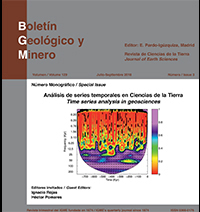Métodos de análisis avanzados aplicados a series paleoclimáticas reconstruidas y simuladas
DOI:
https://doi.org/10.21701/bolgeomin.129.3.003Palabras clave:
paleoclima, modelo de relajación, oscilaciones glacialesResumen
Las series simuladas de CO2 (C) y de volumen de hielo global (V) derivadas de un modelo de relajación de ciclos glaciares-interglaciares (García-Olivares y Herrero, 2013) han sido analizadas usando técnicas lineales y no-lineales para evaluar la habilidad del modelos en simular la dinámica del sistema climático. En una primera aproximación, hemos comparado las series simuladas con su correspondiente serie experimental, obteniendo correlaciones de 0.88 entre el proxy δ18O (Lisiecki y Raymo, 2005) y la simulación V, y 0.79 entre la concentración de CO2 atmosférico (Petit et al., 1999; Indermuhle et al., 2000; Monnin et al., 2001; Siegenthaler et al., 2005; Luthi et al., 2008) y la correspondiente serie, C. El análisis espectral usando la transformada de Fourier y la transformada continua de wavelet resulta útil para cuantificar el rendimiento de un modelo reproduciendo la dinámica incluida dentro de una serie experimental. El análisis muestra que el modelo reproduce adecuadamente la dinámica de la serie de volumen de hielo, pero la coherencia entre la serie simulada y la experimental de CO2 es únicamente esporádica, indicando que ambas series no tienen el mismo comportamiento dinámico, pese a que en los periodos de desglaciación las dos series de carbono tienen un comportamiento muy similar. El análisis refuerza la hipótesis que ciertos mecanismos específicos incluidos en el modelo son capaces de reproducir adecuadamente las oscilaciones glaciares-interglaciares. Estas técnicas pueden aplicarse a otras series climáticas para cuantificar el rendimiento de un modelo simulando la dinámica interna del sistema climático.
Descargas
Citas
Berger, A. 1978. Long term variations of daily insolation and quaternary climatic changes. Journal of the Atmospheric Sciences, 35(12), 2362-2367. https://doi.org/10.1175/1520-0469(1978)035<2362:LTVODI>2.0.CO;2
Bintanja, R., R. S. van de Wal, and Oerlemans, J. 2005. Modeled atmospheric temperatures and global sea levels over the past million years. Nature, 437, 125 - 128. https://doi.org/10.1038/nature03975 PMid:16136140
García-Olivares, A., and Herrero, C. 2012. Fitting the last pleistocene delta o-18 and CO2 time-series with simple box models. Scientia Marina, 76S1, 209-218. https://doi.org/10.3989/scimar.03617.19H
García-Olivares, A., and Herrero, C. 2013. Simulation of glacial- interglacial cycles by simple relaxation models: consistency with observational results. Climate Dynamics, 41(5-6), 1307-1331. https://doi.org/10.1007/s00382-012-1614-7
Grinsted, A., Moore, J., and Jevrejeva, S. 2004. Application of the cross wavelet transform and wavelet coherence to geophysical time series. Nonlinear Processes in Geophysics, 11, 561-566. https://doi.org/10.5194/npg-11-561-2004
Hays, J. D., Imbrie, J., and Shackleton, N. J. 1976. Variations in the earth's orbit: Pacemaker of the ice ages. Science, 194(4270), 1121-1132. https://doi.org/10.1126/science.194.4270.1121 PMid:17790893
Indermuhle, A., Monnin, E., Stauffer, B., Stocker, N. J. and Wahlen, M. 2000. Atmospheric CO2 concentration from 60 to 20 kyr BP from the Taylor Dome Ice Core, Antarctica. Geophysical Research Letters, 27(5), 735-738. https://doi.org/10.1029/1999GL010960
Lisiecki, L. E., and Raymo, M. E. 2005. A Pliocene- Pleistocene stack of 57 globally distributed benthic delta O-18 records. Paleoceanography, 20(1), PA1003. https://doi.org/10.1029/2004PA001071
Luthi, D., Le Floch, M., Bereiter, B., Blunier, T., Barnola, J. M., Siegenthaler, U., Raynaud, D., Jouzel, J., Fischer, H., Kawamura, K., and Stocker, T. F. 2008. High-resolution
carbon dioxide concentration record 650,000-800,000 years before present, Nature, 453(7193), 379-382. https://doi.org/10.1038/nature06949 PMid:18480821
Marwan, N., Romano, M. C., Thiel, M. and Kurths, J. 2007. Recurrence plots for the analysis of complex systems. Physics Reports, 438(5-6), 237-329. https://doi.org/10.1016/j.physrep.2006.11.001
Monnin, E., Indermuhle, A., Dallenbach, A., Fluckiger, J., Bernhard, S., Stocker, T. F., Raynaud, D., and Barnola, J. M. 2001. Atmospheric CO2 concentrations over the last glacial termination, Science. 291, 112-114. https://doi.org/10.1126/science.291.5501.112 PMid:11141559
Paillard, D. 2010. Climate and the orbital parameters of the Earth. Comptes Rendus Geoscience, 342(4-5), 273-285. https://doi.org/10.1016/j.crte.2009.12.006
Paillard, D., and Parrenin, F. 2004. The Antarctic ice sheet and the triggering of deglaciations. Earth and Planetary Science Letters, 227(3-4), 263-271. https://doi.org/10.1016/j.epsl.2004.08.023
Petit, J. R., Jouzel, J., Raynaud, D., Barkov, N. I., Barnola, J. M., Basile, I., Bender, M., Chappellaz, J., Davis, M., Delaygue, G., Delmotte, M., Kotlyakov, V. M., Legrand, M., Lipenkov, V. Y., Lorius, C., Pépin, L., Ritz, C., Saltzman, E., and Stievenard, M., 1999. Climate and atmospheric history of the past 420000 years from the Vostok ice core Antarctica. Nature, 399, 429-436. https://doi.org/10.1038/20859
Roulston, M. S. 1999. Estimating the errors on measured entropy and mutual information, Physica D: Nonlinear Phenomena, 125, 285-294. https://doi.org/10.1016/S0167-2789(98)00269-3
Siegenthaler, U., Stocker, T. F., Monnin, E., Lüthi, D., Schwander, J., Stauffer, B., Raynaud, D., Barnola, J. M., Fischer, H., Masson-Delmotte, V., and Jouzel, J. 2005. Stable carbon cycle-climate relationship during the Late Pleistocene. Science, 310, 1313-1317. https://doi.org/10.1126/science.1120130 PMid:16311332
Tziperman, E., Raymo, M. E., Huybers, P., and Wunsch, C. 2006. Consequences of pacing the pleistocene 100 kyr ice ages by nonlinear phase locking to milankovitch forcing. Paleoceanography, 21(4), PA4206. https://doi.org/10.1029/2005PA001241
Descargas
Publicado
Cómo citar
Número
Sección
Licencia
Derechos de autor 2024 Consejo Superior de Investigaciones Científicas (CSIC)

Esta obra está bajo una licencia internacional Creative Commons Atribución 4.0.
© CSIC. Los originales publicados en las ediciones impresa y electrónica de esta Revista son propiedad del Consejo Superior de Investigaciones Científicas, siendo necesario citar la procedencia en cualquier reproducción parcial o total.
Salvo indicación contraria, todos los contenidos de la edición electrónica se distribuyen bajo una licencia de uso y distribución “Creative Commons Reconocimiento 4.0 Internacional ” (CC BY 4.0). Consulte la versión informativa y el texto legal de la licencia. Esta circunstancia ha de hacerse constar expresamente de esta forma cuando sea necesario.
No se autoriza el depósito en repositorios, páginas web personales o similares de cualquier otra versión distinta a la publicada por el editor.
Datos de los fondos
Agencia Estatal de Investigación
Números de la subvención CTM2011-28867















